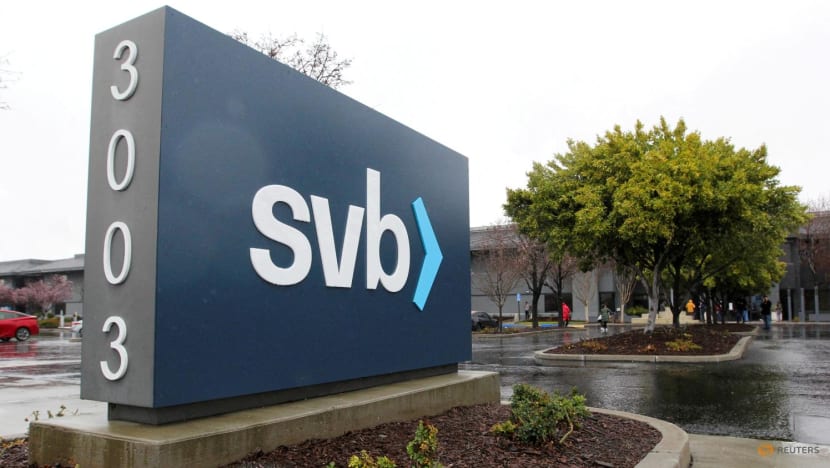Commentary: Silicon Valley Bank collapse - what financial history tells us about the fallout
The collapse of SVB may not prove to be systemic, but there will be lessons for investors and providers of digital currencies, says Huw van Steenis for the Financial Times

A sign for Silicon Valley Bank (SVB) headquarters is seen in Santa Clara, California, US on Mar 10, 2023. (File photo: Reuters/Nathan Frandino)
LONDON: What are the implications of the rapid demise of Silicon Valley Bank (SVB)? That is arguably now the most important question in global finance. What can financial history tell us about what may happen next?
First, Silicon Valley Bank was an outlier in many dimensions. Deposits had tripled since the fourth quarter of 2019 to US$189 billion at the end of 2021. That compared with an industry growth of 37 per cent over the same period, according to Autonomous Research.
SVB also had an unusually high reliance on corporate and venture capital funding. Around 95 per cent of its deposits were uninsured at the end of last year compared with one-third at a sample of major United States banks. The run is reminiscent of the hedge funds who fled their prime brokers in 2008.
Decisively, the bank had made a shockingly large unhedged bet on longer-term bonds at peak prices. Rising rates crushed the trade and the bank was left sitting on an unrealised loss of close to US$16 billion - more than its equity base. Deposit outflows then started to crystallise this into a realised loss.
Given the highly idiosyncratic deposit base skewed to the tech industry and the supersized rates trade, the collapse of SVB may not prove to be systemic. “One bad apple doesn’t spoil the bunch,” Davide Serra, an investor and former banks analyst, argued this weekend.
KEEPING UNINSURED DEPOSITORS WHOLE
But the failure has some important things to say about the broader banking market and implications for the US Federal Reserve.
SVB shares some of the hallmarks of the failure of Continental Illinois in 1984, which was then the largest failure in US banking history. It too had a very unstable uninsured depositor base - with a large skew to international corporate deposits - and it also had a highly concentrated loan book.
Paul Volcker, the Fed chairman at the time, chose pragmatism, organising a rescue with the central bank and the Federal Deposit Insurance Corporation working together.
Today’s policymakers were perhaps caught off guard by the pace of a digital bank run, but the immediate policy response will be pivotal in stemming this panic. Finding a way to keep uninsured depositors whole should be prioritised - something current Fed chair Jerome Powell supported during the Bank of New England bailout in 1991.
BANKS MAY BECOME LESS WILLING TO LEND
History also suggests a few other lessons for investors. First, banks will be far more sensitive to the threat of deposit flight and pay up for funding, tightening financial conditions.
Such competition should push up sharply so-called “deposit betas” - how much of a rate increase banks pass on. Consensus had assumed the cumulative beta for this tightening cycle would be only 40 per cent - but could easily breach past cycles of 55 per cent to 65 per cent, although the strongest banks won’t need to pay up as much.
Banks’ net interest income will be crimped. And they will probably become less willing to lend, including to parts of the tech industry, at least temporarily.
Investors will sift for any other outsized exposures and weak deposit bases. Despite being the 16th-largest US bank, it was unfortunate that SVB was not subject to Fed stress tests, nor the international Basel banking rules on liquidity.
A flight to quality means policymakers will need to act fast with credible fire breaks to stem deposit outflows from other institutions now perceived to be weaker.
IMPACT ON INTEREST RATES
Next, the demise of SVB could augur a macro regime shift in this “Teflon economy”. After the bailout of Continental Illinois, Volcker told the Fed Open Markets Committee: “My bottom line is that we’ve run out of room for the time being for any tightening, given this situation.” Within six months, the Fed cut rates by 0.50 percentage points.
Since monetary policy has a “long and variable lag”, the Fed is likely to become cautious this time but they may choose to pause rate rises or revert to 0.25 percentage point rate increases.
Finally, there could be some tough lessons for providers of so-called digital currencies, including stablecoins that are pegged to fiat currencies, in the need to prepare for sudden customer redemptions. And plans for central bank digital currencies may also be kicked into the long grass.
Central bankers have been at pains to tell us to worry about the non-bank sector for hidden pools of leverage. But what has tripped us up is what is always at the centre of a banking crisis - an outsized exposure to a large asset class deemed to be low risk, in this case, rate risk on US Treasuries.
The retreat from unconventional central banking measures was always going to be exceptionally tricky. SVB just made it a lot harder.
Huw van Steenis is vice-chair at Oliver Wyman and former global head of banks research at Morgan Stanley.


















